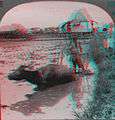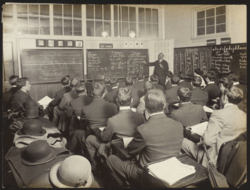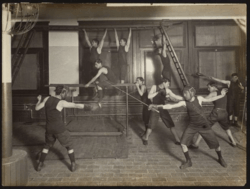Underwood & Underwood
Underwood & Underwood was an early producer and distributor of stereoscopic and other photographic images, and later was a pioneer in the field of news bureau photography.
History
The company was founded in 1881 in Ottawa, Kansas, by two brothers, Elmer Underwood (born Fulton County, Illinois 1859 - died St. Petersburg, Florida 1947) and Bert Elias Underwood (born in Oxford, Illinois 1862 - died Tucson, Arizona 1943).[1] They moved to Baltimore and then to New York City in 1891.[2]
At one time, Underwood & Underwood was the largest publisher of stereoviews in the world, producing 10 million views a year. The Underwood brothers developed a selling system of thorough canvassing using college students. They distributed stereographs for Charles Bierstadt, J.F. Jarvis and the Littleton View Company. By 1887, they outgrew their original office in Ottawa and moved to New York City. Offices were also opened in Canada and Europe. In 1891, Bert learned how to operate a camera and thus the firm of Underwood & Underwood Publishing entered a new merchandising sphere. By 1897, the company had a number of full-time staff and freelance photographers. In the same year, the Underwoods purchased the businesses of Jarvis; Bierstadt; and, William H. Rau. Underwood & Underwood was publishing 25,000 stereographs a day by 1901.[2] The firm still canvassed and sold its own stereographs. Around 1900, Underwood & Underwood introduced boxed sets, with specific themes, such as education and religion, and travel sets depicting popular tourist areas of the world.
By 1910, Underwood & Underwood had entered the field of news photography. Due to this expansion, stereograph production was reduced until the early years of World War I. Altogether Underwood & Underwood produced between 30,000 and 40,000 stereographic titles. In 1920 stereograph production was discontinued and Underwood & Underwood sold its stereographic stock and rights to the Keystone View Company. The Keystone republished images included a V prefix for Underwood source. An example would indicate K24056 as Keystone numbered and the same images V24056 as Underwood and Keystone dual copyrighted.[3]
In 1924-25, Underwood & Underwood took the first vertically controlled aerial photographs of the new cities of Miami and Miami Beach.[4] Approximately 400 images were taken showing the final phase of the first building boom, which collapsed shortly after when the Great Hurricane of 1926 destroyed both locations. The quality of the images was superb for the day and rivals modern aerials in detail due to the low altitude of the aircraft taking them. Little else is known about this aspect of the company's work.
The company ceased business in the 1940s.
Modern appreciation of early stereoviews
Stereoviews were meant to be viewed using a stereoscope, of which there were many types. However, advances in 3D technology have allowed old stereoviews to be reproduced on digital media or the print page to be viewed using paper glasses. Anaglyph 3D is the name given to the stereoscopic 3D effect achieved by means of encoding each eye's image using filters of different (usually chromatically opposite) colors, typically red and cyan. Anaglyph 3D images contain two differently filtered colored images, one for each eye. When viewed through the "color-coded" "anaglyph glasses", each of the two images reaches the eye it's intended for, revealing an integrated stereoscopic image. The visual cortex of the brain fuses this into perception of a three-dimensional scene or composition.[5]
Gallery
 Underwood and Underwood Stereoscopic source image for the following anaglyph
Underwood and Underwood Stereoscopic source image for the following anaglyph Stereo monochrome image anaglyphed for red (left eye) and cyan (right eye) filters.
Stereo monochrome image anaglyphed for red (left eye) and cyan (right eye) filters.
 1897 View # 2 The Temple of Olympian Zeus and the Acropolis in the background
1897 View # 2 The Temple of Olympian Zeus and the Acropolis in the background 1897 View # 13 The Panathenaic Stadium
1897 View # 13 The Panathenaic Stadium 1897 View # 33 The archaeological site at Epidaurus
1897 View # 33 The archaeological site at Epidaurus 1897 View # 35 Shepherds leading sheep to the Nafplion Market
1897 View # 35 Shepherds leading sheep to the Nafplion Market 1897 View # 41 The Treasury of Atreus at Mycenae
1897 View # 41 The Treasury of Atreus at Mycenae 1897 View # 43 The Lion Gate at Mycenae
1897 View # 43 The Lion Gate at Mycenae 1897 View # 93 The Monastery of the Holy Trinity, Meteora
1897 View # 93 The Monastery of the Holy Trinity, Meteora "The First and Hardest Battle-the call to War".{Called upon to Enlist} 1900.
"The First and Hardest Battle-the call to War".{Called upon to Enlist} 1900. "Farewell Darling I go to fight for Queen and Country" 1900
"Farewell Darling I go to fight for Queen and Country" 1900 "Sad News from the Battlefield" 1900.
"Sad News from the Battlefield" 1900. "On Furlough-the glad reunion" 1900.
"On Furlough-the glad reunion" 1900..jpg) "The Story of the Battle" 1900.
"The Story of the Battle" 1900. Children's Aid Society from Harvard's Underwood & Underwood 1909 Collection
Children's Aid Society from Harvard's Underwood & Underwood 1909 Collection CAS from Harvard's Underwood & Underwood 1909 Collection
CAS from Harvard's Underwood & Underwood 1909 Collection CAS from Harvard's Underwood & Underwood 1909 Collection
CAS from Harvard's Underwood & Underwood 1909 Collection CAS from Harvard's Underwood & Underwood 1909 Collection
CAS from Harvard's Underwood & Underwood 1909 Collection
References
- "Underwood and Underwood". Smithsonian American Art Museum. Retrieved 13 March 2010.
- Kansas Historical Society (June 2011). "Elmer and Bert Underwood". Kansas Historical Society. Retrieved 1 March 2012.
- Perez, Christian. "Keystone View Company". www.manilaoldtimer.net.
- "NSGL". nsgl.gso.uri.edu.
- Alexander, Klein. "Anaglyhs". stereoscopy.com. Retrieved 28 August 2018.
- "The Aerodrome Forum query June 27, 2014. Accessed August 26,2018".
- Note apparently Zeppelin sheds used to store Fokker DVII aircraft at AMW C214653
External links
![]()